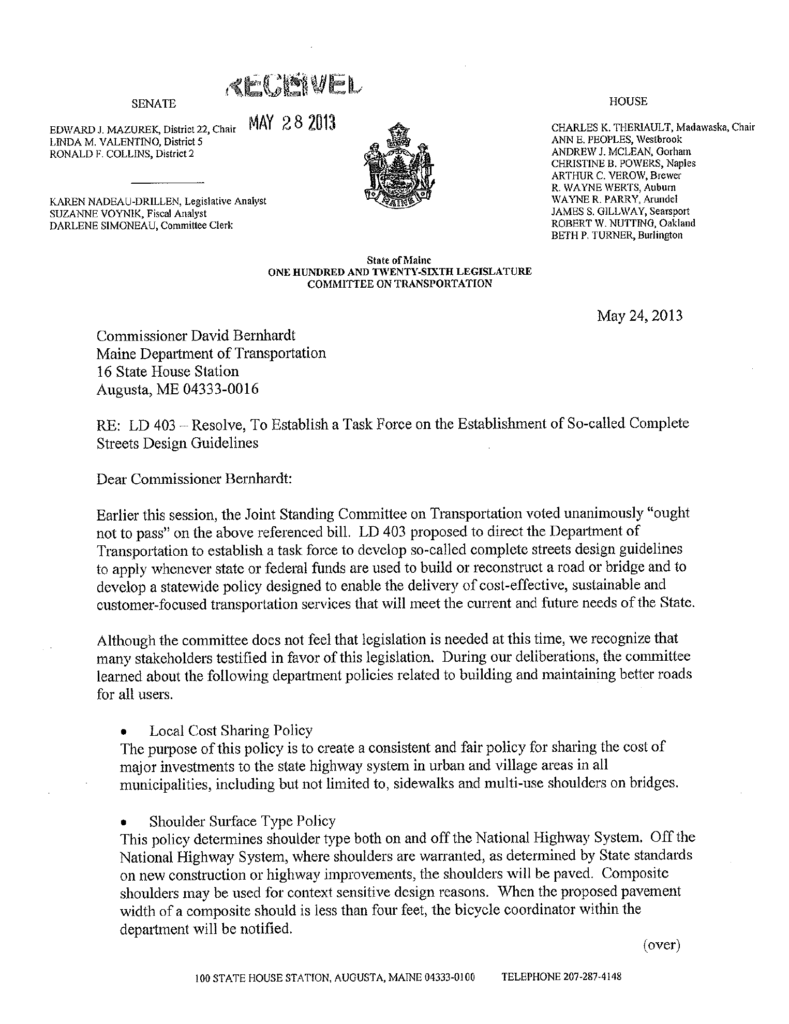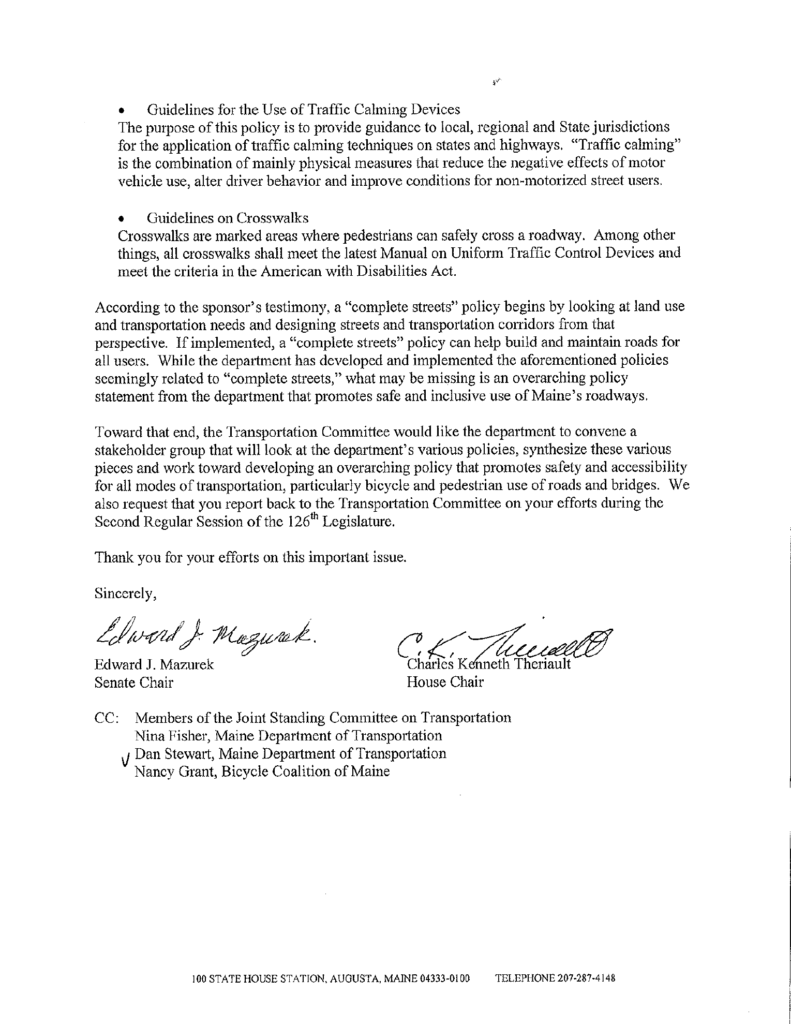January 15, 2014
STAKEHOLDER REPORT ON
LD 1528, RESOLVE, TO PROVIDE FOR LIVEABLE, AFFORDABLE NEIGHBORHOODS
TO THE JOINT STANDING COMMITTEE ON ENVIRONMENT AND NATURAL RESOURCES
LD 1528 Stakeholder Meeting Participants:
Liz Hertz Municipal Planning Assistance Program, Dept of Agriculture, Conservation and Forestry
Bill Norbert Finance Authority of Maine
Peter Merrill MaineHousing
Nina Fisher MaineDOT
Dan Stewart MaineDOT
Tom Abello The Nature Conservancy
Jennifer Burns Gray Maine Audubon
Barbara Berry Maine Association of Realtors
Geoff Hermann Maine Municipal Association
Tex Haeuser Maine Association of Planners, City of South Portland
Evan Richert Richert Planning
Nancy Grant Bicycle Coalition of Maine
Jane Lafleur Friends of Midcoast Maine
Greg Paxton Maine Preservation
Nancy Smith GrowSmart Maine
Hon. Dick Campbell State Representative, bill sponsor
During the time between legislative sessions, a stakeholder group came together three times to discuss the content and intent of LD 1528 with the purpose of returning in the Second Regular Session of the 126th Legislature with specific recommendations for the Joint Standing Committee on Environment and Natural Resources. The bill sponsor, Representative Richard Campbell, and GrowSmart Maine Executive Director Nancy Smith, led the stakeholder group, which was comprised of organizations from various sectors: finance, development and real estate, environmental, municipal and planning. Experts from outside of Maine were invited to speak at the first two meetings, adding knowledge and perspective to the expertise on the stakeholder group. Discussions were respectful and purposeful and this letter is the result of a consensus process.
Stakeholders were guided by three parameters:
A. Stakeholders focused on how to best implement the important purposes outlined in the bill:
1. Encourage economic growth and investment
2. Ensure the financial capacity for communities to sustain local services
3. Encourage compact village design and walkable neighborhoods as a preferred alternative to low-density sprawl
4. MaineDOT incorporate principles of Sensible Transportation Policy Act in their work plan
5. Encourage the productive use of rural lands
B. Stakeholders acknowledged two points:
1. That market demand is shifting to meet the purposes listed above
2. That state and municipal budgets are under great strain.
The first point demonstrates improved climate for this work while the second indicates a serious challenge to achieving results.
C. Stakeholders recognized three constraints to achieving these goals:
1. No legislative mandates on municipalities
2. No state fiscal note
3. There has been a significant reduction of land use planning capacity at the state level over perhaps the last dozen years and the recent decentralization of remaining state planning capacity makes it more difficult for the state to actively lead on these issues.
Given these observations, goals and constraints, the stakeholder group offers several recommendations to the Committee on Environment and Natural Resources (ENR).
First, a set of recommendations appropriate for all portions of the bill:
PROMOTE AND IMPROVE ACCESS TO EXISTING RESOURCES AND PROGRAMS, MODEL ORDINANCES AND PROPERTY TAX ADVANTAGES IN COMPACT DEVELOPMENT. There are high-quality, relevant resources available to Maine communities with which to achieve the goals of LD 1528, but many improvements can be made in educating municipalities of the value and availability of these tools. This is best done in collaboration by relevant government agencies, non-profits and municipalities through:
A. Convenings and workshops
B. Online resources
C. Written Materials
DEMONSTRATION PROJECTS provide tangible examples of the impact of the tools available so should be encouraged and existing demonstration projects highlighted. Projects that achieve the purpose of this legislation could be made eligible for certain funding or expedited regulatory process and the outcomes shared broadly across the state.
Secondly, recommendations specific to Parts A and C. Part B of the Resolve requires no specific recommendations as the conservation of open space is a natural result of Part C.
PART A: TRANSPORTATION
As an outcome of LD 403 “Resolve, To Establish a Task Force on the Establishment of So-called Complete Streets Design Guidelines”, the Transportation Committee wrote a letter to MaineDOT requesting them to take steps very similar to those sought in this legislation. MaineDOT notes that the work requested is underway. (letter attached)
PART C: COMPACT VILLAGE DEVELOPMENT, applicable in rural, suburban and urban communities.
Improve existing financial tools addressing financial barriers to achieving goals of LD 1528:
1. Patient Sewer Extension Loan: This funding mechanism, created to help communities implement their comprehensive plans, is administered by DEP and Maine Municipal Bond Bank. The advantage of this program is an extended payback period to allow time for lots in village and similar settings, where sewer lines for new development need to be built, to be sold/developed and thus produce the revenue to retire the loan. The source of funding is the Clean Water State Revolving Loan Fund, which also funds other sewer projects. The PSEL has not been used, perhaps because of a lack of awareness of its potential and prior lack of market demand. It was noted that communities could use an Affordable Housing TIF to service the debt of this loan. ACTION RECOMMENDED: ENR Committee write a letter encouraging Municipal Planning Assistance Program and Dept of Environmental Protection to explore the potential costs and benefits of a demonstration project with RFP for two such projects that have both municipal and developer support.
2. Upstairs/Downstairs Financing: FAME and MaineHousing have in the past worked collaboratively in financing properties/projects with mixed use of housing and business. FAME would require that 51% of the space-area-footprint be devoted to business. A new MOU would be required for this funding mechanism to be available. Promotion of the concept, as noted above, could then commence. ACTION RECOMMENDED: ENR Committee write a letter to encourage FAME and MaineHousing sign a new Memorandum of Understanding to again make available this funding mechanism.
In closing, the stakeholders who committed to working on this Resolve shared an interest in achieving the goals Representative Campbell outlined in LD 1528. Given the reality that proposing municipal mandates or additional state costs is not plausible or even desirable, it was challenging to develop feasible recommendations to the committee. The recommendations included here are for action by the Committee as well as by various stakeholders. The combination of outreach to Maine communities by stakeholders and to various agencies by the Committee can work in tandem to assist Maine municipalities in providing for livable, affordable communities.


